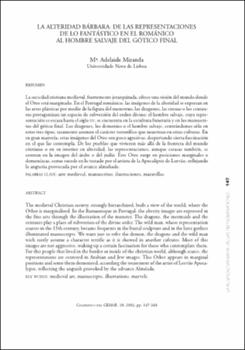La alteridad bárbara: de las representaciones de lo fantástico en el románico al hombre salvaje del gótico final
Author
Miranda, María AdelaideDate
2002Abstract
The medieval Christian society, strongly hierarchized, built a view of the world, where the Other is marginalized. In the Romanesque in Portugal, the alterity images are expressed in the fine arts through the illustration of the monster. The dragons, the mermaids and the centaurs play a place of subversion of the divine order. The wild man, whose representation scarces in the 15th century, became frequents in the burial sculpture and in the later gothics illuminated manuscripts. We want just to refer the demon, the dragons and the wild man wich rarely assume a character terrific as it is showed in another cultures. Most of this images are not aggressive, waking up a certain fascination for those who contemplate them.
For this people that lived in the border or inside of the christian world, although scarce, the representations are centered in Arabian and Jew images. This Other appears in marginal positions and some them demonised, according the treatement of the artist of Lorvão Apocalypse, reflecting the anguish provoked by the advance Almóada. La sociedad cristiana medieval, fuertemente jerarquizada, ofrece una visión del mundo donde
el Otro está marginado. En el Portugal románico, las imágenes de la alteridad se expresan en
las artes plásticas por medio de la figura del monstruo; los dragones, las sirenas o los centauros protagonizan un espacio de subversión del orden divino; el hombre salvaje, cuya representación es escasa hasta el siglo XV, se encuentra en la escultura funeraria y en los manuscritos del gótico final. Los dragones, los demonios o el hombre salvaje, centrándonos sólo en
estos tres tipos, raramente asumen el carácter terrorífico que muestran en otras culturas. En
su gran mayoría, estas imágenes del Otro son poco agresivas, despertando cierta fascinación
en el que las contempla. De los pueblos que vivieron más allá de la frontera del mundo
cristiano o en su interior en alteridad, las representaciones, aunque escasas también, se
centran en la imagen del árabe o del judío. Este Otro surge en posiciones marginales o
demoníacas, como sucede en lo tratado por el artista de la Apocalipsis de Lorvão, reflejando
la angustia provocada por el avance almohade.





